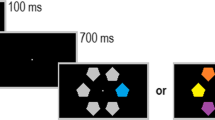Abstract
We tested the hypothesis that frontal eye field (FEF) visual activity integrates visual information with a template of a target by examining whether a target that is not present in a search display influences the target selection in FEF. Neural activity was recorded in FEF of macaque monkeys performing visual search for a singleton target defined by color or direction of motion. The target remained constant throughout, but not across experimental sessions. Trials with distractors dissimilar to the target were interleaved with trials with distractors similar to the target. The hypothesis was tested by measuring the magnitude of activity in randomly interleaved trials with the target absent and only distractors in the display. We found that the response to the distractors was significantly greater when presented with displays consisting of distractors that resembled the absent target than when presented with displays consisting of distractors most different from the absent target. The influence of target-distractor similarity on FEF activity was also observed when the target was present, as reported previously. These data suggest that a template of the absent target can influence the selection process in FEF. This provides more direct evidence that FEF integrates visual information and knowledge of the target to determine the goal of a saccade.




Similar content being viewed by others
References
Basso MA, Wurtz RH (1998) Modulation of neuronal activity in superior colliculus by changes in target probability. J Neurosci 18:7519–7534
Bichot NP, Schall JD (1999a) Saccade target selection in macaque during feature and conjunction visual search. Vis Neurosci 16:81–89
Bichot NP, Schall JD (1999b) Effects of similarity and history on neural mechanisms of visual selection. Nat Neurosci 2:549–554
Bichot NP, Schall JD, Thompson KG (1996) Visual feature selectivity in frontal eye fields induced by experience in mature macaques. Nature 381:697–699
Bichot NP, Thompson KG, Rao SC, Schall JD (2001) Reliability of macaque frontal eye field neurons signaling saccade targets during visual search. J Neurosci 21:713–725
Britten KH, Shadlen MN, Newsome WT, Movshon JA (1992) The analysis of visual motion: a comparison of neuronal and psychophysical performance. J Neurosci 12:4745–4765
Bruce CJ, Goldberg ME (1985) Primate frontal eye fields. I. Single neurons discharging before saccades. J Neurophysiol 53:603–635
Bundesen C (1990) A theory of visual attention. Psychol Rev 97:523–547
Chelazzi L, Duncan J, Miller EK, Desimone R (1998) Responses of neurons in inferior temporal cortex during memory-guided visual search. J Neurophysiol 80:2918–2940
Chelazzi L, Miller EK, Duncan J, Desimone R (2001) Responses of neurons in macaque area V4 during memory-guided visual search. Cereb Cortex 11:761–772
Chun MM, Jiang Y (1998) Contextual cueing: implicit learning and memory of visual context guides spatial attention. Cognit Psychol 36:28–71
Constantinidis C, Franowicz MN, Goldman-Rakic PS (2001) The sensory nature of mnemonic representation in the primate prefrontal cortex. Nat Neurosci 4:311–316
Crist CF, Yamasaki DS, Komatsu H, Wurtz RH (1988) A grid system and a mircrosyringe for single cell recording. J Neurosci Methods 26:117–122
Desimone R, Duncan J (1995) Neural mechanism of selective visual attention. Annu Rev Neurosci 18:193–222
Duncan J, Humphreys GW (1989) Visual search and stimulus similarity. Psychol Rev 96:433–458
D'Zmura M (1991) Color in visual search. Vision Res 31:951–966
Findlay JM (1997) Saccade target selection during visual search. Vision Res 37:617–631
Goldberg ME, Bushnell MC (1981) Behavioral enhancement of visual responses in monkey cerebral cortex. II. Modulation in frontal eye fields specifically related to saccades. J Neurophysiol 46:773–787
Hanes DP, Schall JD (1996) Neural control of voluntary movement initiation. Science 274:427–430
Hikosaka O, Wurtz RH (1983) Visual and oculomotor functions of monkey substantia nigra pars reticulata. III. Memory-contingent visual and saccade responses. J Neurophysiol 49:1268–1284
Horwitz GD, Newsome WT (1999) Separate signals for target selection and movement specifications in the superior colliculus. Science 284:1158–1161
Horowitz TS, Wolfe JM (1998) Visual search has no memory. Nature 394:575–577
Kim J-N, Shadlen MN (1999) Neural correlates of a decision in the dorsolateral prefrontal cortex of the macaque. Nature Neurosci 2:176–185
Kodaka Y, Mikami A, Kubota K (1997) Neuronal activity in the frontal eye field of the monkey is modulated while attention is focused on to a stimulus in the peripheral visual field, irrespective of eye movement. Neurosci Res 28:291–298
Mohler CW, Goldberg ME, Wurtz RH (1973) Visual receptive fields of frontal eye field neurons. Brain Res 61:385–389
Moore T, Fallah M (2001) Control of eye movements and spatial attention. Proc Natl Acad Sci U S A 98:1273–1276
Murthy A, Thompson KG, Schall JDF (2001) Dynamic dissociation of visual selection from saccade programming in frontal eye field. J Neurophysiol 86:2634–2637
Nagy AL, Sanchez RR (1990) Critical color differences determined with a visual search task. J Opt Soc Am A7:1209–1217
Pashler H (1987) Target-distractor discriminability in visual search. Percept Psychophys 41:285–292
Reynolds JH, Pasternak T, Desimone R (2000) Attention increases sensitivity of V4 neurons. Neuron 26:703–714
Sato T, Schall JD (2001) Salience coding by frontal eye field in macaque monkeys. Soc Neurosci Abstr 27:59.13
Sato TR, Schall JD (2003) Effect of stimulus-response compatibility on neural selection in frontal eye field. Neuron 38:637–648
Sato T, Murthy A, Thompson KG, Schall JD (2001) Search efficiency but not response interference affects visual selection in frontal eye field. Neuron 30:583–591
Sayer RJ, Friedlander MJ, Redman SJ (1990) The time course and amplitude of EPSPs evoked at synapses between pairs of CA3/CA1 neurons in hippocampal slice. J Neurosci 10:826–836
Schall JD (1997) Visuomotor areas of the frontal lobe. In: Rockland KS, Peters A, Kaas JH (eds) Cerebral cortex (vol. 12): extrastriate cortex of primates. Plenum, New York, pp 527–638
Schall JD, Hanes DP (1993) Neural basis of saccade target selection in frontal eye field during visual search. Nature 366:467–469
Schall JD, Thompson KG (1999) Neural selection and control of visually guided eye movements. Annu Rev Neurosci 22:241–259
Schall JD, Hanes DP, Thompson KG, King DJ (1995) Saccade target selection in frontal eye field of macaque. I. Visual and premovement activation. J Neurosci 15:6905–6918
Shadlen MN, Newsome WT (2001) Neural basis of a perceptual decision in the parietal cortex (area LIP) of the rhesus monkey. J Neurophysiol 86:1916–1936
Spitzer H, Desimone R, Moran J (1988) Increased attention enhances both behavioral and neural performance. Science 240:338–340
Thompson KG, Hanes DP, Bichot NP, Schall JD (1996) Perceptual and motor processing stages identified in the activity of macaque frontal eye field neurons during visual search. J Neurophysiol 76:4040–4055
Thompson KG, Bichot NP, Schall JD (1997) Dissociation of visual discrimination from saccade programming in macaque frontal eye field. J Neurophysiol 77:1046–1050
Treisman A, Gormican S (1988) Feature analysis in early vision: evidence from search asymmetries. Psychol Rev 95:15–48
Wolfe JM (1994) Guided Search 2.0: a revised model of visual search. Psychon Bull Rev 1:202–238
Wolfe JM, Cave KR, Franzel SL (1989) Guided search: an alternative to the feature integration model for visual search. J Exp Psychol Hum Percept Perform 15:419–433
Woodman GF, Vogel EK, Luck SJ (2001) Visual search remains efficient when visual working memory is full. Psychol Sci 12:219–224
Wurtz RH, Mohler CW (1976) Enhancement of visual responses in monkey striate cortex and frontal eye fields. J Neurophysiol 39:766–772
Acknowledgements
We thank J. Gold and M. Shadlen for providing the software for the motion display; S. Hoffman for guidance with TEMPO; S. Shimojo, Y. Kamitani, and H. Pashler for valuable discussions; and M. Chun, F. Ebner, S. Ito, G. Logan, R. Marois, S. Shorter-Jacobi and G. Woodman for their helpful comments on the manuscript. This work was supported by R01-EY08890 and P30-EY08126. K.W. is supported by Research Fellowships of the Japan Society for the Promotion of Science for Young Scientists. J. Schall is a Kennedy Center Investigator.
Author information
Authors and Affiliations
Corresponding author
Rights and permissions
About this article
Cite this article
Sato, T.R., Watanabe, K., Thompson, K.G. et al. Effect of target-distractor similarity on FEF visual selection in the absence of the target. Exp Brain Res 151, 356–363 (2003). https://doi.org/10.1007/s00221-003-1461-1
Received:
Accepted:
Published:
Issue Date:
DOI: https://doi.org/10.1007/s00221-003-1461-1




